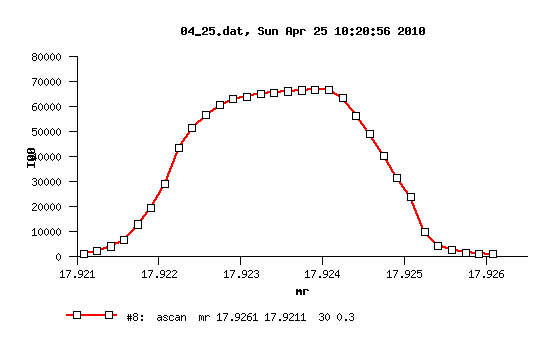HDF5 in Python with h5py¶
One way to gain a quick familiarity with NeXus is to start working with some data. For at least the
first few examples in this section, we have a simple two-column set of 1-D data, collected as part of a
series of alignment scans by the APS USAXS instrument during the time it was stationed at
beam line 32ID. We will show how to write this
data using the Python language and the h5py package [1]
(using h5py calls directly rather than using the NeXus NAPI). The
actual data to be written was extracted (elsewhere) from a spec [2] data file
and read as a text block from a file by the Python source code.
Our examples will start with the simplest case and add only mild complexity with each new case
since these examples are meant for those who are unfamiliar with NeXus.
Code examples¶
Example data used¶
The data shown plotted in the next figure will be written to the NeXus HDF5 file
using only two NeXus base classes, NXentry and NXdata, in the first example
and then minor variations on this structure in the next two examples. The
data model is identical to the one in the Introduction
chapter except that the names will be different, as shown below:

data structure of the simple example¶
1/entry:NXentry
2 /mr_scan:NXdata
3 /mr : float64[31]
4 /I00 : int32[31]

plot of the simple example data¶
Simple example values
117.92608 1037
217.92591 1318
317.92575 1704
417.92558 2857
517.92541 4516
617.92525 9998
717.92508 23819
817.92491 31662
917.92475 40458
1017.92458 49087
1117.92441 56514
1217.92425 63499
1317.92408 66802
1417.92391 66863
1517.92375 66599
1617.92358 66206
1717.92341 65747
1817.92325 65250
1917.92308 64129
2017.92291 63044
2117.92275 60796
2217.92258 56795
2317.92241 51550
2417.92225 43710
2517.92208 29315
2617.92191 19782
2717.92175 12992
2817.92158 6622
2917.92141 4198
3017.92125 2248
3117.92108 1321
